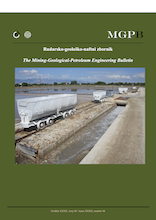Stability assessment of underground openings using different rock support systems
DOI:
https://doi.org/10.17794/rgn.2020.1.5Keywords:
Numerical modelling, rock support systems, performance of tunnel support, underground excavations, instability evaluation criteriaAbstract
Rock support systems have become widely dominant components in underground hard rock mines. They are used to maintain the stability of underground openings and reinforce disturbed rock masses after creating an excavation or start- ing mining activity. Thus, the objective of this study is to examine the effect of support types on the performance stabil- ity of underground tunnels that exist in hard rock mines, in terms of deformation, the extent of failure zones and the strength of the rock mass surrounding the tunnel. This, in turn, will help in the selection of an appropriate support system that mitigates the stress-deformation conditions around the tunnel. Herein, four models have been built using the RS2D program, simulated and introduced to evaluate the behaviour of an underground tunnel with different rock support systems. The first model is simulated without any support system, whereas, rock bolts have been installed in the second model. The third model applied only shotcrete, while rock bolts and shotcrete are combined together in the fourth model. The results are presented and discussed in terms of strength factor, the extent of yielding zones and rock mass displacement/convergence. The results show that tunnel stability suffers when there is no rock support at all, while, it is significantly improved when the rock support system is installed. The optimum improvement is obtained when both shotcrete and rock bolts are employed together.
Downloads
Published
How to Cite
Issue
Section
License
Copyright (c) 2019 authors and journal

This work is licensed under a Creative Commons Attribution 4.0 International License.
Creative Commons-BY
Authors who publish with this journal agree to the following terms:
In agreeing this form, you certify that:
- You read the ethical codex of the RGN zbornik available at journal web.
- You submitted work is your original work, and has not previously been published and does not include any form of plagiarism.
- You own copyright in the submitted work, and are therefore permitted to assign the licence to publish to RGN zbornik.
- Your submitted work contains no violation of any existing copyright or other third party right or any material of an obscene, libellous or otherwise unlawful nature.
- You have obtained permission for and acknowledged the source of any illustrations, diagrams or other material included in the work of which you are not the copyright owner.
- You have taken due care to ensure the accuracy of the work, and that, to the best of your knowledge, there are no false statements made within it.
- All co-authors of this submitted work are aware of, and in agreement with, the terms of this licence and that the submitted manuscript has been approved by these authors.
Publication licence
You retain copyright in your submitted work, according to journal license policy (CC-BY). By signing this form you agree that RGN zbornik may publish it under the publication licence. In summary the licence allows the following:
Anyone is free:
- To copy, distribute, display, and perform the work.
- To make derivative works.
Under the following conditions:
- The original author must always be given credit.
- The work may not be used for commercial purposes.
- If the work is altered, transformed, or built upon, the resulting work may only be distributed under a licence identical to this one.
Exceptions to the licence
In addition to publishing the work printed under the above licence, RGN zbornik will also enable the work to be visible online.
The journal editorial can change the licence rules anytime but it cannot retroactively restrict author(s) rights.


